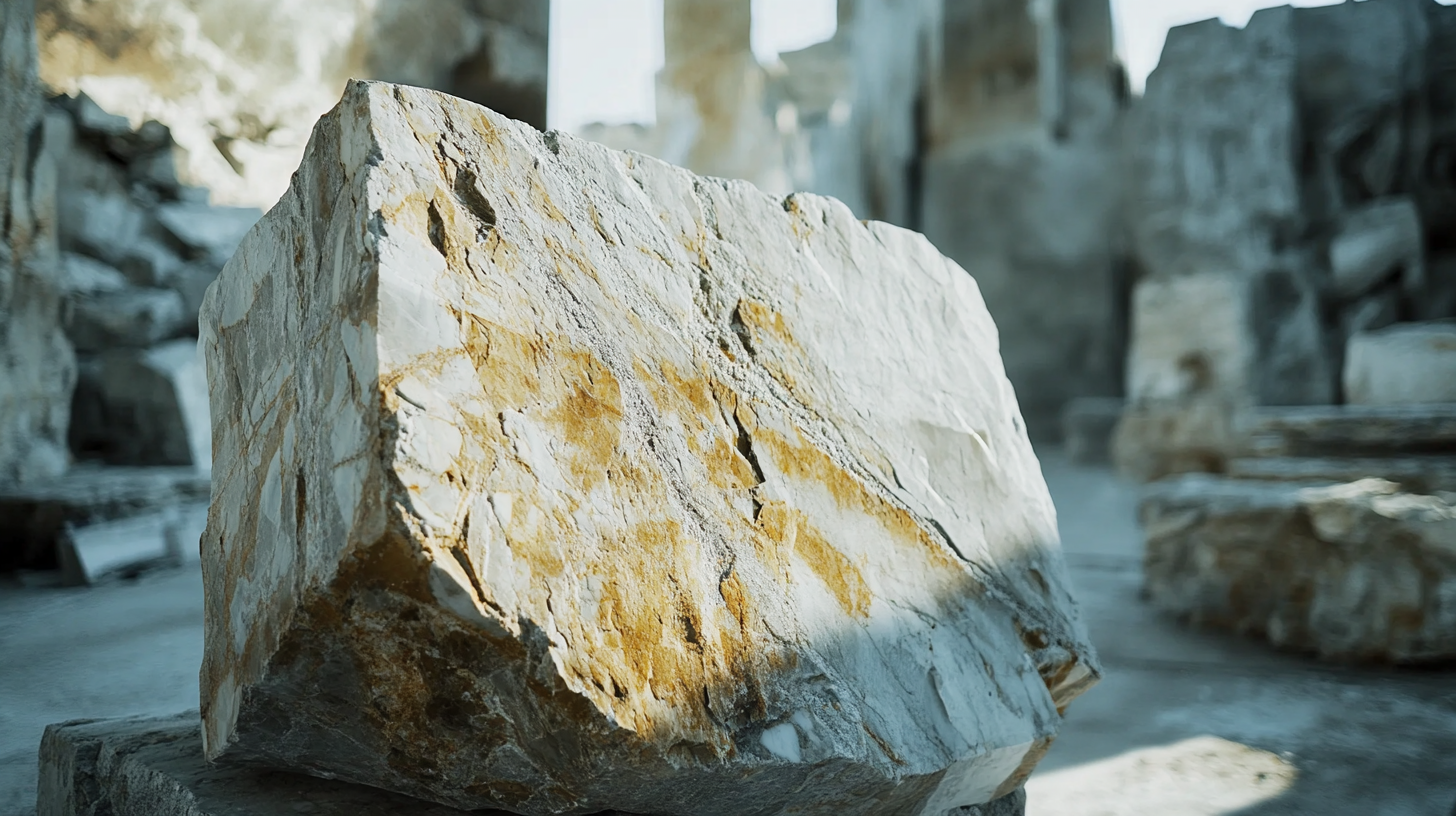Blog
Navigating Global Trade Regulations for Quartzite Stone: A Comprehensive Guide
Navigating the complexities of global trade regulations is essential for industries involved in the procurement and distribution of Quartzite Stone. As a vital material known for its durability and aesthetic appeal, quartzite has seen a significant increase in demand, particularly in the construction and landscaping sectors. According to a recent market report by Grand View Research, the global quartzite market is projected to reach USD 18.97 billion by 2025, expanding at a compound annual growth rate (CAGR) of 4.9%. This surge is indicative of the growing importance of quartzite in various architectural applications, necessitating a thorough understanding of the regulatory landscape surrounding its trade.
As countries evolve in their regulatory frameworks, importers and exporters must stay informed to navigate potential challenges effectively. Various trade agreements and tariffs can influence the accessibility and pricing of Quartzite Stone, making it crucial for businesses to stay ahead of compliance requirements. The World Trade Organization (WTO) has highlighted that non-tariff measures can significantly impact trade flows, emphasizing the importance of understanding these regulations in mitigating risks and optimizing supply chains. This comprehensive guide aims to equip stakeholders with the necessary insights to successfully navigate the global trade of quartzite, ensuring smooth operations in this booming market.

Understanding Quartzite Stone: Characteristics and Applications in Global Markets
Quartzite stone, a natural metamorphic rock, is renowned for its durability and aesthetic appeal, making it a popular choice in construction and design industries worldwide. According to a report by Grand View Research, the global quartzite market was valued at approximately USD 1.3 billion in 2020, with expectations to reach USD 2.2 billion by 2027, growing at a CAGR of 7.8%. This growth is largely driven by the rising demand for high-quality flooring, countertop materials, and wall cladding in residential and commercial sectors. The unique characteristics of quartzite, such as its high resistance to heat and scratching, make it an ideal material for various applications. It is often used in premium kitchens and bathrooms, and its appealing color variations add to its market appeal. A recent study by Technavio highlights that the increasing consumer preference for natural stones over artificial materials is further propelling the demand for quartzite. As architects and designers seek sustainable and aesthetically pleasing materials, quartzite’s versatility positions it favorably in global markets. Moreover, the regulations surrounding global trade for quartzite stone can significantly impact its availability and pricing. Different countries impose specific import and export regulations, which are crucial for industry stakeholders to understand. With growing awareness about sustainable sourcing, compliance with environmental regulations has become paramount. Companies must navigate these complexities to optimize their supply chains and leverage the growing market potential of this remarkable stone.

Key Global Trade Regulations Affecting Quartzite Stone Import and Export
Navigating the complex landscape of global trade regulations is crucial for industries dealing with quartzite stone, a popular material known for its durability and aesthetic appeal. The import and export of quartzite are influenced by various regulations that differ from country to country, making it essential for businesses to stay informed. The World Trade Organization (WTO) reports indicate that international trade in stone products has been steadily increasing, with an estimated market size of over $100 billion in 2022. However, compliance with local customs regulations, tariffs, and safety standards remains a significant challenge for exporters and importers alike.
One critical regulation affecting quartzite trade is the Harmonized System (HS) codes, which classify products and determine applicable tariffs. According to a recent analysis by the International Trade Centre, quartzite falls under specific HS codes that streamline the customs process but require precise documentation. Failing to correctly declare the HS code can result in delays and increased costs, highlighting the necessity for businesses to maintain accurate shipping documents.
Additionally, environmental regulations play a pivotal role in the trade of quartzite, especially in regions where sustainable mining practices are mandated. The United Nations Environment Programme (UNEP) emphasizes the importance of eco-friendly extraction methods to mitigate the environmental impact of mining activities. Compliance with these regulations not only ensures the sustainability of operations but also enhances the marketability of quartzite products in eco-conscious markets, where consumers increasingly favor sustainably sourced materials. Companies must understand and adapt to both environmental and trade regulations to remain competitive in the evolving global market for quartzite.

Navigating Tariffs and Duties: What Quartzite Exporters Need to Know
Navigating the complexities of tariffs and duties is crucial for quartzite exporters aiming to thrive in the global market. According to a 2021 report by the U.S. International Trade Commission, the demand for quartzite is projected to grow by approximately 5% annually, driven by the booming construction and landscaping industries. However, navigating the intricate landscape of tariffs can pose significant challenges to exporters and impact their competitiveness.
The Harmonized System (HS) codes for quartzite and related stone products can significantly influence the duties levied on shipments. For instance, in the United States, quartzite slabs imported under HS code 2516.90 can be subjected to tariffs ranging from 0% to 7%, depending on the country of origin. Exporters must stay informed about trade agreements such as the USMCA, which can provide favorable tariff rates for products originating from Canada and Mexico, thereby allowing exporters to reduce overhead costs and price their products more competitively.
Additionally, exporters must also be aware of anti-dumping duties that may apply to specific goods. In 2020, the Department of Commerce assessed anti-dumping duties on imported ornamental stone products from several countries, which can reach as high as 40%. This underscores the importance of thorough market research and compliance with regulatory requirements to mitigate risks associated with non-compliance and unexpected costs. By properly navigating these tariffs and duties, quartzite exporters can position themselves effectively to capitalize on the expanding global demand for this versatile and aesthetically appealing stone.

Compliance with Quality Standards: Ensuring Your Quartzite Meets International Criteria
The international trade landscape for quartzite stone is marked by stringent quality standards that must be adhered to. Compliance with these standards is crucial for businesses aiming to compete in global markets. Quartzite, being a popular stone for various applications including countertops, flooring, and landscaping, requires assessment against regulations that govern the physical and chemical properties of the material. Ensuring that your quartzite meets international quality criteria not only helps in gaining customer trust but also mitigates the risks associated with trade discrepancies.
As the demand for sustainable materials rises, particularly in the context of broad electrification efforts such as photovoltaic (PV) technology, the importance of adhering to quality standards becomes more pronounced. The photovoltaics industry is increasingly focused on reducing carbon footprints and enhancing energy efficiency. Similarly, quartzite producers must evaluate their practices in light of these global sustainability trends. It is vital to engage in transparent sourcing and production methods that satisfy not just market demands, but also environmental regulations. By prioritizing compliance with quality standards, quartzite businesses can position themselves as leaders in both the stone industry and the broader movement towards sustainable construction practices.
With the right attention to quality standards and compliance regulations, quartzite companies can effectively navigate the complexities of global trade. This includes understanding and adhering to diverse regulations in different regions, which can vary greatly yet share a common goal: to ensure the delivery of safe, high-quality materials to consumers worldwide.
Strategies for Successful Global Partnerships in the Quartzite Trade
In navigating the global quartzite trade, developing strategic international partnerships is essential for success amid shifting economic landscapes. Recent trends indicate that China, now Africa's largest trading partner, is reevaluating its economic relations on the continent. This shift creates an opportunity for quartzite exporters to forge partnerships that leverage local resources while responding to changing trade regulations and demands. As reported by the World Bank, Africa's mineral trade, including quartzite, has seen significant growth, with exports rising by 20% over the last five years, indicating a robust market for strategic collaboration.
The initiative “Collaborative Global Ventures” highlights the importance of building resilient networks that support sustainable trade. By fostering relationships between established markets and emerging economies, quartzite companies can gain access to vital resources and innovations. According to a report from the International Trade Centre, businesses that actively engage in strategic partnerships often experience a 30% increase in market reach. Such collaborations enable stakeholders to share knowledge, reduce risks associated with regulatory compliance, and enhance their competitive edge in the global marketplace.
Additionally, the Standards and Trade Development Facility (STDF) has outlined a clear strategy for 2025-2030 to promote safe and effective trade practices. This framework can guide quartzite exporters in aligning with international standards while navigating complex regulatory environments. By prioritizing safety and compliance, companies can enhance product quality and create stronger trust with partners worldwide. Utilizing digital platforms for communication and collaboration further supports the establishment of strategic alliances that drive growth in the quartzite market.

